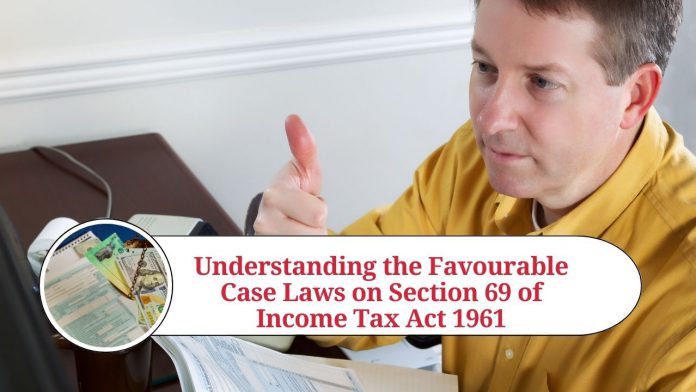Section 69 of the Income Tax Act 1961 deals with the unexplained investments, cash credits, and expenditures that cannot be accounted for by the taxpayer. It empowers the Income Tax authorities to add such unexplained income to the total income of the assessee and levy taxes on the same. However, over the years, several case laws have emerged in favour of the assessee, offering a glimmer of hope to those who find themselves in a precarious situation due to Section 69.
In this blog, we will discuss some of the landmark judgments that have gone in favour of the assessee in cases related to Section 69 of the Income Tax Act.
- CIT v. Durga Prasad More (1971) 82 ITR 540 (SC)
This case is considered as one of the most important and seminal cases on the concept of ‘unexplained investments’ under Section 69 of the Income Tax Act. The Supreme Court held that if the assessee can provide a reasonable explanation for the source of the investment, then such investment cannot be treated as unexplained. In this case, the assessee had claimed that the unexplained cash credits represented his cash-in-hand savings from his agricultural income, which was accepted by the court.
- CIT v. Divine Leasing & Finance Ltd. (2001) 248 ITR 338 (Delhi HC)
In this case, the Delhi High Court held that merely because the assessee could not provide a satisfactory explanation for the source of the cash credit, it could not be added to the total income of the assessee. The court observed that the Assessing Officer (AO) must establish a direct nexus between the unexplained investment and the assessee’s income, failing which the addition could not be made.
- CIT v. S.V. Angidi Chettiar (1962) 44 ITR 739 (SC)
This case was the first-ever judgment passed by the Supreme Court on Section 69 of the Income Tax Act. The court held that the addition under Section 69 could not be made merely on the ground that the assessee had failed to explain the source of the cash credits. The AO must have some material to show that the credits are genuine or that they represent income.
- Kishinchand Chellaram v. CIT (1980) 125 ITR 713 (SC)
In this case, the Supreme Court held that the addition under Section 69 could not be made on the basis of suspicion or conjecture. The AO must have some material to show that the cash credits are unexplained and represent the assessee’s income. In the absence of such material, the addition could not be made.
- CIT v. Taikisha Engineering India Ltd. (2016) 381 ITR 666 (Delhi HC)
In this case, the Delhi High Court held that the mere fact that the assessee could not provide a satisfactory explanation for the source of the investment could not lead to the presumption that it was the assessee’s income. The court held that the AO must have some material to show that the investment represented the assessee’s income before making the addition under Section 69.
In conclusion
the judgments discussed above offer some relief to the assessee who find themselves in a precarious situation due to Section 69 of the Income Tax Act. The judgments emphasize that the addition under Section 69 cannot be made on the basis of conjecture, suspicion, or mere failure of the assessee to explain the source of the cash credit.
Read more useful content:
- section 234e of income tax act
- section 286 of income tax act
- section 90a of income tax act
- section 40a(7) of income tax act
- section 226(3) of income tax act
- section 24 of income tax act
Frequently Asked Questions (FAQs)
Q: What is Section 69 of the Income Tax Act, 1961?
A: Section 69 of the Income Tax Act, 1961 empowers the Income Tax authorities to add unexplained investments, cash credits, and expenditures to the total income of the assessee and levy taxes on the same.
Q: Are there any case laws in favour of the assessee related to Section 69?
A: Yes, several landmark judgments have emerged in favour of the assessee in cases related to Section 69 of the Income Tax Act.
Q: What is the significance of the case law CIT v. Durga Prasad More (1971) 82 ITR 540 (SC)?
A: The case is considered as one of the most important and seminal cases on the concept of ‘unexplained investments’ under Section 69 of the Income Tax Act. The Supreme Court held that if the assessee can provide a reasonable explanation for the source of the investment, then such investment cannot be treated as unexplained.
Q: Can an addition under Section 69 be made solely on the ground that the assessee failed to explain the source of the cash credit?
A: No, several case laws such as CIT v. Divine Leasing & Finance Ltd. (2001) 248 ITR 338 (Delhi HC) and CIT v. S.V. Angidi Chettiar (1962) 44 ITR 739 (SC) have established that the addition cannot be made solely on the ground of unexplained cash credits.
Q: What is the significance of Kishinchand Chellaram v. CIT (1980) 125 ITR 713 (SC)?
A: The Supreme Court held that the addition under Section 69 cannot be made on the basis of suspicion or conjecture. The Assessing Officer must have some material to show that the cash credits are unexplained and represent the assessee’s income.
Q: Can an addition under Section 69 be made if the assessee cannot provide a satisfactory explanation for the source of the investment?
A: No, the Delhi High Court in CIT v. Taikisha Engineering India Ltd. (2016) 381 ITR 666 (Delhi HC) held that the mere failure of the assessee to provide a satisfactory explanation for the source of the investment could not lead to the presumption that it was the assessee’s income. The AO must have some material to establish a direct nexus between the investment and the assessee’s income before making the addition.




















